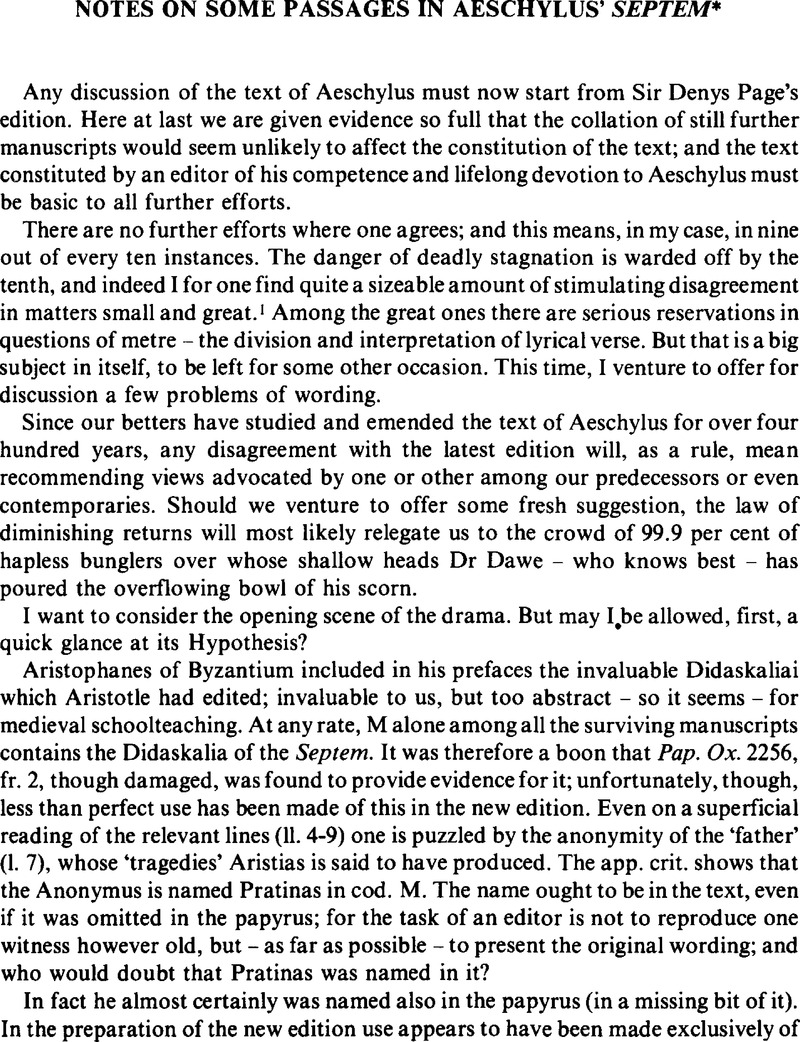No CrossRef data available.
Article contents
Notes on some passages in Aeschylus' Septem*
Published online by Cambridge University Press: 28 February 2013
Abstract

- Type
- Other
- Information
- Copyright
- Copyright © The Author(s). Published online by Cambridge University Press 1981
References
NOTES
1. I would make my own words of Professor H. Lloyd-Jones in his review (CR n.s. 26 (1976) 7)Google Scholar: ‘The difficulties of the text of Aeschylus are so great that any person who has given them serious thought will find in any new edition things with which he strongly disagrees… this should not obscure my admiration for a magnificent piece of work’, eqs.
2. In Die Didaskalie der Septem (1848).
3. E.g. in Diodorus, 2. 65 and other sources, which he could find assembled in Clinton, H.'s Fasti Hellenici, ed. Krueger, C. G. (1830)Google Scholar The two forms of the name are equivalent; see Wilhelm, A., Urkunden dramat Auffünrungen (1906) 133Google Scholar and G. Murray ad loc.
4. After Vita Sophoclis 19, Athenaeus 15 686A, etc.; all the evidence now apud Snell, B., Trag. Graec. Fragmenta IGoogle Scholar.
5. Many similar instances are quoted in Kühner-Gerth, II 577ff, esp. 580Google Scholar. A marginal note in M, ![]()
![]() is not a variant reading but the correct explanation, differing from the later scholia and punctuation.
is not a variant reading but the correct explanation, differing from the later scholia and punctuation.
6. Oddly, though, the transposition was there ascribed to Paley.
7. Schwyzer, E., Griech. Gramm. I 493.5Google Scholar ‘vereinzelt ![]() Aesch. neben
Aesch. neben ![]() ’.
’.
8. Clay, D. M. gives the full evidence in ch. 23 of her admirably complete Analysts of the vocabularies of Aeschylus Sophocles and Euripides (1957)Google Scholar.
9. Wilamowitz quotes Q (Qc Dawe) L K R Ργρ.; add Lc Pd W X (pace ed. Oxon).
10. What seems to be the majority read ![]() , attracted by
, attracted by ![]() following.
following.
11. Jahrbuch der Oesterreichischen Byzanuntschen Gesellschaft 16 (1967) 8Google Scholar and 24, fr. 15; cf. Herodianus, , Prosodia Catholica ed. Lentz, A. (1867) (repr. 1956) 171Google Scholar.
12. Herodianus (171.10 Lentz) derives also ![]() (A Suppl. 1027) from
(A Suppl. 1027) from ![]() , but Chantraine, P., Dictionn étymol. 427Google Scholar, is duly sceptical.
, but Chantraine, P., Dictionn étymol. 427Google Scholar, is duly sceptical. ![]() (an alternative to
(an alternative to ![]() in Hippocrates) may be compared (Schwyzer, , Gr. Gramm. I 494.8Google Scholar).
in Hippocrates) may be compared (Schwyzer, , Gr. Gramm. I 494.8Google Scholar).
13. Greek grammarians did not regard adjectives as a separate class of words, but, very sensibly, took them for one among several varieties of the noun ![]() It is therefore not surprising that Herodianus quotes ‘nouns’ and ‘adjectives’ (in the modern sense) pell-mell (e.g. 167.1 Lentz; ib. 22; 169.9; 171.9) and thus – in my view –
It is therefore not surprising that Herodianus quotes ‘nouns’ and ‘adjectives’ (in the modern sense) pell-mell (e.g. 167.1 Lentz; ib. 22; 169.9; 171.9) and thus – in my view – ![]() and
and ![]() in the palimpsest, after
in the palimpsest, after ![]() et sim. Only where special rules apply to them, does he mention
et sim. Only where special rules apply to them, does he mention ![]() separately (e.g. 161.5; 162.6; 167.21; 170.13).
separately (e.g. 161.5; 162.6; 167.21; 170.13).
14. ![]() . for
. for ![]() ed. princ., was suggested by Dr A. L. Brown – metrically and stylistically satisfactory, but leaving out of account the uncertain preceding letters.
ed. princ., was suggested by Dr A. L. Brown – metrically and stylistically satisfactory, but leaving out of account the uncertain preceding letters.
15. For further close analogies see Italie, , Index…, 142Google Scholar, r.
16. Cp., Plato, Crito 46aGoogle Scholar![]() , contrast Soph. 241b4 ώρα
, contrast Soph. 241b4 ώρα ![]() .
.
17. E.g. Sept. 158, 227, 466, 516, 609, 750, 794; Pers. 294 etc., Prom. 267, cp. 248, etc.
18. The collation and investigation of manuscripts of Aeschylus (1964) 180Google Scholar.
19. Nor is there any need to change the wording at Agam. 851.
20. W. Kranz argued on similar lines in his book Stasimon (1933) 71 ffGoogle Scholar.
21. Professor H. Lloyd-Jones, 1.c. 7, made the same observation.
22. The app. crit. at 123 ![]() plurimi' leaves the user puzzled He would like to know, at least, on which authority rests the reading in the text,
plurimi' leaves the user puzzled He would like to know, at least, on which authority rests the reading in the text, ![]() On consulting Wilamowitz and Dawe he finds that the evidence for it is hardly smaller than for its competitor and is headed by the cod. Mediceus. The information on 45, 429, 436, 568, 657 is in a similar manner disappointing.
On consulting Wilamowitz and Dawe he finds that the evidence for it is hardly smaller than for its competitor and is headed by the cod. Mediceus. The information on 45, 429, 436, 568, 657 is in a similar manner disappointing.
23. Professor Kenney added a stark instance previously mentioned to him by Dr Dawe: the text of 988, where an unattested ![]() has taken the place of the transmitted, and unobjectionable, ή (correct in 977).
has taken the place of the transmitted, and unobjectionable, ή (correct in 977).




